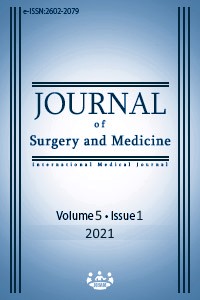Serum pregnancy-associated placental protein-a (PAPP-A) levels are increased in polycystic ovary syndrome (PCOS) in women with oligo-anovulation
Keywords:
polycystic ovary syndrome;, cardiovascular disease;, pregnancy associated placental protein-A;, PAPP-AAbstract
Background/Aim: Pregnancy associated placental protein-A (PAPP-A) is a zinc-binding metalloproteinase with a key role in insulin like growth factor (IGF) pathway, and potential atherogenic effects. There is little information in the literature regarding PAPP-A levels in Polycystic ovary syndrome (PCOS). We aimed to investigate the serum PAPP-A levels among non-obese women with PCOS as a cardiovascular risk marker. Methods: Non-obese women of reproductive age (18-35 years of age) diagnosed with PCOS according to Rotterdam Consensus Conference criteria were included in this case-control study. Serum PAPP-A levels were compared with independent samples t-test between two main groups (PCOS and control) and investigated in PCOS subgroups as PCOS patients were further classified according to main phenotypes (hyperandrogenism and oligo-anovulation). Results: A total of 41 women with PCOS and 40 age- and body mass index- matched controls were included in the analysis. The serum PAPP-A levels of the control and PCOS groups, and of PCOS patients with hyperandrogenism were similar (P=0.128, P=0.261, respectively). However, the serum PAPP-A levels of those with oligo-anovulation was higher than those without (P=0.006), and that of women without oligo-anovulation was comparable to that of the control group (P=0.613). Conclusion: Lean and young PCOS women with oligo-anovulation had increased serum levels of PAPP-A when compared to women without. Prospective studies are needed to uncover the long-term cardiovascular risk of elevated PAPP-A levels in PCOS women with oligo-anovulation.
Downloads
References
Dumesic DA, Oberfield SE, Stener-Victorin E, Marshall JC, Laven JS, Legro RS. Scientific Statement on the Diagnostic Criteria, Epidemiology, Pathophysiology, and Molecular Genetics of Polycystic Ovary Syndrome. Endocr Rev. 2015;36(5):487–525.
Li Y, Chen C, Ma Y, Xiao J, Luo G, Li Y, Wu D. Multi-system reproductive metabolic disorder: significance for the pathogenesis and therapy of polycystic ovary syndrome (PCOS). Life Sci. 2019;228:167-75.
Lizneva D, Suturina L, Walker W, Brakta S, Gavrilova-Jordan L, Azziz R. Criteria, prevalence, and phenotypes of polycystic ovary syndrome. Fertil Steril. 2016;106(1):6–15.
Kilic D, Kilic ID, Sevgican CI, Kilic O, Alatas E, Arslan M, et al. Arterial stiffness measured by cardio-ankle vascular index is greater in non-obese young women with polycystic ovarian syndrome. J Obstet Gynaecol Res. 2020;4. doi: 10.1111/jog.14543.
Delitala AP, Capobianco G, Delitala G, Cherchi PL, Dessole S. Polycystic ovary syndrome, adipose tissue and metabolic syndrome. Arch Gynecol Obstet. 2017;296(3):405–19.
Torchen LC. Cardiometabolic Risk in PCOS: More than a Reproductive Disorder. Curr Diab Rep. 2017;17(12):137.
Tsutsumi A. Prevention and management of work-related cardiovascular disorders. Int J Occup Med Environ Health. 2015;28(1):4–7.
Calderon-Margalit R, Siscovick D, Merkin SS, Wang E, Daviglus ML, Schreiner PJ, et al. Prospective association of polycystic ovary syndrome with coronary artery calcification and carotid-intima-media thickness: the Coronary Artery Risk Development in Young Adults Women’s study. Arterioscler Thromb Vasc Biol. 2014;34(12):2688–94.
Lin T-M, Halbert SP, Spellacy WN. Measurement of Pregnancy-Associated Plasma Proteins during Human Gestation. J Clin Invest. 1974;54(3):576–82.
Steffensen LB, Conover CA, Oxvig C. PAPP-A and the IGF system in atherosclerosis: what’s up, what’s down? Am J Physiol Heart Circ Physiol. 2019;317(5):H1039–49.
Consuegra-Sanchez L, Fredericks S, Kaski JC. Pregnancy-associated plasma protein-A (PAPP-A) and cardiovascular risk. Atherosclerosis. 2009;203(2):346–52.
Conover CA, Bale LK. Loss of pregnancy-associated plasma protein A extends lifespan in mice. Aging Cell. 2007;6(5):727–9.
Junnila RK, List EO, Berryman DE, Murrey JW, Kopchick JJ. The GH/IGF-1 axis in ageing and longevity. Nat Rev Endocrinol. 2013;9(6):366–76.
Cirillo P, Conte S, Pellegrino G, Ziviello F, Barra G, De Palma R, et al. Pregnancy-associated plasma protein-A promotes TF procoagulant activity in human endothelial cells by Akt-NF-κB axis. J Thromb Thrombolysis. 2016;42(2):225–32.
Firmansyah A, Chalid MT, Farid RB, Nusratuddin N. The correlation between insulin-like growth factor binding protein 1 (IGFBP-1) and homeostasis model assessment of insulin resistance (HOMA-IR) in polycystic ovarian syndrome with insulin resistance. Int J Reprod Biomed. 2018;16(11):679–82.
Öztürk M, Öktem M, Altinkaya SÖ, Öktem EÖ, Elbeg Ş, Erdem A, et al. Elevated PAPP-A levels in lean patients with polycystic ovary syndrome. Taiwan J Obstet Gynecol. 2018 Jun;57(3):394-8.
Giancarlo P, Helmut OS, Annette H, Jessica C, Ginger H, Marguerite KS, et al. Polycystic Ovary Syndrome Is Associated With Endothelial Dysfunction. Circulation. 2001;103(10):1410–5.
Bajuk Studen K, Jensterle Sever M, Pfeifer M. Cardiovascular risk and subclinical cardiovascular disease in polycystic ovary syndrome. Front Horm Res. 2013;40:64–82.
Glintborg D, Rubin KH, Nybo M, Abrahamsen B, Andersen M. Cardiovascular disease in a nationwide population of Danish women with polycystic ovary syndrome. Cardiovascular Diabetology. 2018;17(1):37.
Oliver-Williams C, Vassard D, Pinborg A, Schmidt L. Risk of cardiovascular disease for women with polycystic ovary syndrome: results from a national Danish registry cohort study. Eur J Prev Cardiol. 2020;(2):2047487320939674. doi: 10.1177/2047487320939674.
Carmina E, Lobo RA. Is There Really Increased Cardiovascular Morbidity in Women with Polycystic Ovary Syndrome? J Womens Health (Larchmt). 2018;27(11):1385–8.
Daan NMP, Louwers YV, Koster MPH, Eijkemans MJC, de Rijke YB, Lentjes EWG, et al. Cardiovascular and metabolic profiles amongst different polycystic ovary syndrome phenotypes: who is really at risk? Fertil Steril. 2014;102(5):1444-1451.e3.
Jovanovic VP, Carmina E, Lobo RA. Not all women diagnosed with PCOS share the same cardiovascular risk profiles. Fertility and Sterility. 2010;94(3):826–32.
Polycystic Ovary Syndrome: ACOG Practice Bulletin, Number 194. Obstetrics & Gynecology. 2018;131(6):e157.
Papanastasiou CA, Kokkinidis DG, Oikonomou EK, Mantziaris VG, Foley TR, Karamitsos TD, et al. Pregnancy associated plasma protein-A as a prognostic biomarker of all-cause mortality and cardiovascular events in patients presenting with chest pain: a systematic review. Biomarkers. 2018;23(1):1–9.
Downloads
- 561 715
Published
Issue
Section
How to Cite
License
Copyright (c) 2021 Derya Kılıç, Ömer Tolga Güler
This work is licensed under a Creative Commons Attribution-NonCommercial-NoDerivatives 4.0 International License.
















